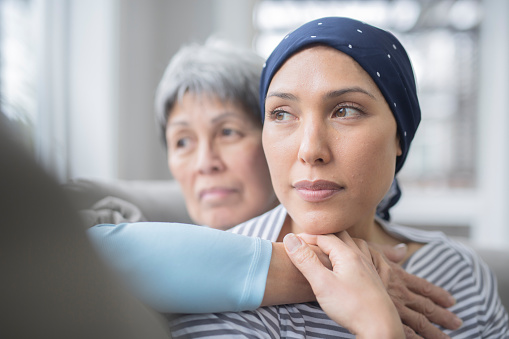October marks the beginning of Breast Cancer Awareness Month, an annual observance dedicated to raising awareness about the disease, and to show support for all those affected by it. More importantly, it is a time devoted to educating others about possible warning signs, available treatment options, the importance of early detection, and the improvements being made to survival rates as a result of breakthroughs in research and technology, new therapies, and timely, individualised care.
But even with these advancements, rates of breast cancer persist: In 2020, the WHO estimated that 2.3 million new cases were diagnosed—accounting for roughly a third of all new cancer diagnoses among women, and approximately 12 percent of all cancer diagnoses worldwide. By the end of 2020, there were 7.8 million women living with breast cancer, making it the most prevalent type of cancer. In the US alone, it is estimated that one in eight women will be diagnosed with breast cancer in their lifetime, while the American Cancer Society predicts that 287,850 new cases of invasive breast cancer will be diagnosed just this year—with a new diagnosis taking place every two minutes.
That means that every two minutes, someone is going through the awful ordeal of receiving gut-wrenching news. Even though five-year survival rates average out at around 90 percent in most high-income countries—with early intervention securing survival probabilities as high as 99 percent—receiving a cancer diagnosis and going through treatment can still be a traumatic and life-changing experience, producing an array of complex emotions, coupled with a wide range of physical symptoms as well as major lifestyle changes. These may include feelings of fear, anger, anxiety, and despair in response to receiving a diagnosis; feelings of isolation, loss, guilt or grief due to changes in relationships, one’s work, school, or home life and one’s living or financial situations; as well as adverse physical and psychological side effects of cancer treatments and medications.
Overview of Breast Cancer Treatment and Possible Side Effects
After receiving a diagnosis, there are a variety of clinical routes that an individual can take to effectively mitigate breast cancer and its effects. While these options vary based on the type, stage, grade, and size of the breast cancer—as well as the patient’s overall health and personal preferences—the most common treatment option is a combination of surgery and the use of chemotherapy, radiotherapy, and hormone therapy. And while each of these strategies boast high success rates, they are still incredibly daunting experiences on both mind and body, beset with unfavourable short- and long-term effects and challenges that can diminish patients’ quality of life.1
To better understand the adverse impacts that treatment can have on breast cancer patients’ overall health, the following is a quick overview of the most common treatment options, their purpose, and their functions:
- Surgery: Most patients with breast cancer will undergo some type of surgery as part of their treatment. The two main types of surgery include breast-conserving surgery (lumpectomy), which removes the cancer without removing the breast, and typically requires the use of additional treatment such as radiation or chemotherapy; or a mastectomy, which removes the entire breast or broth breasts, depending on necessity. As is common with all operations, surgery for breast cancer comes with the risk of bleeding, pain, and infection at the surgery site, as well as pain, numbness, and swelling (or lymphedema).
- Radiotherapy (or ‘radiation therapy’): Radiotherapy is the use of high-powered beams or radiation to kill cancer cells and shrink tumours, and is performed either by aiming beams at a patient’s body (external beam radiation), or by placing radioactive substances inside the body to treat cancer internally (brachytherapy). It is most commonly used in tandem with lumpectomy to fight remaining cancer cells and prevent recurrence. Since this treatment requires exposure to radioactive particles, it not only affects cancer cells, but nearby healthy cells as well, and often produces side effects such as fatigue, tiredness or weakness; itchy, red or dry skin; and swelling or changes in shape, size, and feel of the breast.
- Chemotherapy: Chemotherapy is the use of drugs to kill fast-producing cancer cells. It is often used as a way to treat cancer in tandem with or as an alternative to surgeries, as can be used as a way to prevent cancer from spreading and to ease some of its symptoms. Therefore, it is the most commonly used to treat stage III and metastatic (stage IV) breast cancer, in which case the removal of cancer cells may not be possible.2 While effective, chemotherapy can sometimes kill healthy cells in addition to cancer cells, which can produce serious side effects, the most common of these being ‘chemobrain,’ the name given to the cognitive changes that can accompany chemotherapy, causing impairments in memory, concentration and attention, information processing, and executive functioning.
- Hormone Therapy: Hormone therapy is the use of hormone inhibitors to treat breast cancers that are sensitive to hormones, preventing hormones from attaching to cancer cells—which would allow them to grow and spread. Research shows that roughly two thirds of breast cancers are hormone receptor-positive, and can therefore be treated via hormone therapy. Because this treatment typically blocks or lowers estrogen, it often produces menopausal symptoms such as hot flashes, night sweats, and changes to a patient’s menstrual cycle.
The singular use or combination of any of these treatment options, as stated, produces a range of effects on a patient’s day-to-day life and functioning, impacting their physical, social, and psychological functioning. These side effects include:
Physical Changes:
- Weakness or fatigue.
- Nausea or vomiting. According to one study, the most common reported side effect among patients receiving chemotherapy treatment was nausea and vomiting (79 percent).
- Aches, sores, pain, and swelling. Research shows that roughly a third of patients develop chronic pain after surgery or radiation therapy, while other studies suggest that one fifth of patients will develop cancer-related arm lymphedema within the first few years after treatment.
- Changes in taste and smell.
- Loss of appetite or food sensitivities.
- ‘Chemobrain’ (cognitive impairment).
- Chemo-related cognitive impairment (CRCI) affects more than half of all patients treated with chemotherapeutic drugs; a figure which jumps to three-fourth of all patients with cancers outside of the nervous system, which includes breast cancer. Common side effects include confusion or delirium—which affects up to 85 percent of patients; poor memory and word recall; slow or deficient information processing; and difficulty concentrating.
- Constipation or diarrhoea.
- Sleep disturbance, including insomnia.
- Infertility and early menopause.
- Some treatments—specifically gonadotoxic agents used as part of chemotherapy—have been found to induce premature menopause, while higher doses of chemotherapy have been linked to lower fertility, particularly among male patients.3-4
- Weight gain or weight loss.
- Hair loss (alopecia).
- Sexual health changes. A new study published by the University of Colorado Cancer Centre has revealed that over 70 percent of breast cancer patients experience changes to their sexual health during and/or after treatment, including pain and discomfort, dryness, dysfunction and diminished libido.
Social Changes:
- Social isolation.
- Perceptions of stigma. Studies have found that perceptions of stigma among all breast cancer patients are relatively high due to the physical and psychosocial stress that they experience.5 Changes to one’s appearance due to surgery, weight loss, or weight gain has been associated with feelings of ‘shame’ that increase over time, one Portuguese study revealed; while a study from Thailand reported that stigma was associated with false perceptions regarding the cause and nature of the disease.6 Further, a lack of cultural competency among healthcare professionals is associated with higher rates of perceived stigma—and more severe symptoms overall—among Black patients.
- Interference with work and family responsibilities.
- Interference with relationships.
- Physical displacement or relocation.
- Financial strain.
Psychological Changes:
- Depression. One in four people with any type of cancer may have major or clinical depression; while it is estimated that 70 percent of cancer survivors experience depression at some point during or following treatment.
- Anxiety.
- Body image issues. Physical changes brought on by breast cancer and treatments, including hair loss, weight change, rashes, scars, and breast removals, can have a negative impact on patients’ body and self-image, causing them to feel self-conscious, upset, angry, and can even lower sexual health.7
- Worries about intimacy.
- Disgust/Self-disgust. Emerging research has established a new category of psychological symptoms under the term, ‘emotional chemobrain.‘ The new study identifies disgust and self-disgust as common symptoms among cancer patients due to their restricted autonomy and the psychological effects of chemotherapy.
- Fear and uncertainty.
- Loneliness.
- Anger or frustration.
- Guilt or grief.
How This Impacts Patients’ Emotional Health and Wellbeing
With these processes and side effects in mind, receiving a diagnosis and going through the stages of treatment can have a detrimental impact on patients’ emotional health and overall wellbeing, causing a tremendous amount of distress, discomfort, doubt, and despair. Consequently, patients may start to exhibit signs of hopelessness, depression, and neglect towards their mental and physical health. They may start to eat poorly, either by eating fewer meals, eating too much, or eating foods with poor nutritional value. They may withdraw from friends, family, and co-workers. They might drop out of activities or organisations that—before their diagnosis—brought them joy, pleasure, or energy. They might develop poor sleeping habits, or exhibit insomnia. Lastly, they may turn to disordered and dangerous coping mechanisms, including abusing or misusing alcohol, cigarettes, caffeine, and other drugs to escape from their mental anguish.
‘Being unable to sleep at night, getting up during the night, perhaps eating too much or too little…[are] some physical symptoms that indicate that one is living in a state of high stress or high anxiety,’ explains Dr. Lidia Schapira, medical oncologist at Stanford Medicine. ‘Or even some emotional or psychological issues, like not being able to organise one’s thoughts, having a difficult time making decisions about treatment, being anxious about receiving test results—those are clues to the clinicians and also to the patient’s family or loved ones that the person really has an enormous amount of distress.’
How to Manage Emotions During Treatment
- Acknowledge and accept your feelings. In order to effectively manage one’s emotions during treatment, patients must first be able to identify the emotions that they are experiencing, and secondly be able to understand that what they are experiencing is normal and justified. Over a third of all cancer patients suffer from a psychiatric disorder, studies show, including anxiety and mood disorders like depression, bipolar, and post-traumatic stress disorder. Signs that a patient may be struggling with a mental health disorder include frequent or excessive crying, hostility and irritability, extreme or chronic sadness and hopelessness, excessive worrying and helplessness, social withdrawal, extreme tiredness, and suicidal ideation. Patients must be able to name and identify these feelings as well as other potential symptoms in order to be able to work through them and gradually reduce them.
In addition to being able to identify them, patients need to give themselves permission to sit with their feelings and confront them, rather than avoid or repress them. In fact, research suggests that by directing attention toward their diagnosis and toward their reactions to it, patients may experience psychological growth and may be able to better adapt and adjust to the changes to their everyday life. This means allowing oneself to feel angry about their diagnosis; to ask ‘Why me?‘ To feel uncertain or worried about what’s to come; to ask ‘What’s going to happen to me?’ and ‘Will I get better?’ Taking the time to process these emotions and these questions will allow patients to be able to move forward and use their feelings in a constructive, positive way. For example, after taking the time to experience sadness, grief, and despair about what a patient perceives as loss—loss of autonomy, loss of good health, loss of connectedness, and perhaps loss of opportunities—patients can start to work with those feelings to improve their mindset and to cope with their diagnosis and treatment by gaining a newfound appreciation for all of life’s small moments, gifts, and experiences, and a commitment to taking advantage of them.
- Talk to your doctor or treatment team about how you feel. Only once a patient is able to identify and describe what is happening to them internally can they seek external support. A pivotal first contact for cancer patients to open up to is their treatment team: their oncologists, their surgeons, their nurses, their physical therapists, and perhaps their counsellors and psychiatrists, for those who might have them. Though it’s up for debate whose responsibility it is to talk to whom about how a patient is mentally and emotionally coping with their diagnosis and treatment process, the general rule is that clinical staff will not be able to provide timely and effective emotional support to their patients if they are not made aware of the emotions or feelings that the patients are experiencing.
As one study found, less than half of cancer survivors report that they have discussions about the impact that cancer could have on their emotional wellbeing with their medical teams, and subsequently lack knowledge about resources and services that they can access for support. By voicing their concerns to their doctors, patients can seek to reduce this barrier to support by finding out directly from their team the options that they have to access support for their mental and emotional health. Not only that, but initiating conversations with their medical team and becoming involved in the team’s decision-making process can help to reduce patients’ feelings of helplessness and restore their sense of autonomy, which will improve their overall health and produce better health outcomes.
- Reach out for support; let your family and friends help you. It can be hard for some people to accept help—especially people who feel as though they would be letting others down by relying on their help, or not being able to sufficiently manage their day-to-day tasks independently. This rings true especially for people struggling with a cancer diagnosis. Feelings of powerlessness and the loss of total autonomy or control can be unbearable for many, and needing to reach out to others for support can be seen as embarrassing or shameful. Thus, many patients will avoid seeking help or pretend that they don’t need it. But in fact, asking friends, family, co-workers, and neighbours for help can be a vital source of relief—potentially restoring one’s sense of autonomy and control over their lives by allowing them to get the rest that they need to recover and recharge their energy levels.
‘I think the most important thing in my message to anyone diagnosed with cancer,’ Dr. Schapira imparts, ‘is that it’s important to feel connected; it’s important to actually be sincere enough and self-aware enough to know that it is a good time to get some help.’
‘Everybody diagnosed with cancer needs help of some sort,’ she further explains. ‘Maybe it’s informal help: from loved ones, family, friends or folks in one’s community. And maybe it’s formal help.’ It’s important for patients to remember that it’s okay not to be okay, and to turn to the people in their lives for support; whether that means asking someone to pitch in around the house, asking a colleague to take a task or assignment off their plate, or just letting their friends treat them to a night out—or a night in.
- Join a support group. ‘There are [also] other ways of asking for help and getting help these days,’ Dr. Schapira argues. ‘Many people find help through online communities. Many people find help also in formal support groups that are led by social workers in medical centres. People may find help in their church or in their faith communities.’
Like Dr. Schapira states, there are plenty of peer support groups or services that patients can get involved in both virtually and in-person. For example, Imerman Angels and 4th Angel are both organisations that provide free one-on-one support for cancer fighters, previvors, survivors, and caregivers by connecting them to a mentor angel: a cancer survivor or caregiver who is roughly the same age and gender, who shares similar life circumstances, and who had the same or a similar cancer diagnosis. The Susan G. Komen organisation also provides a list of support resources that patients can use to locate local, online, or telephone support programmes. To locate in-person support programmes, patients can talk to their treatment team or social worker to inquire about local services.
- Develop and stick to a routine. Another effective way to manage emotions and alleviate feelings of uncertainty is to develop and stick to a routine that is both stabilising and relaxing, argues Liz McCary, vice president of marketing at Colliers International, who was diagnosed with metastatic breast cancer in 2018 at the age of 33.
‘No matter how awful I felt that morning after chemo or the week after,’ she tells Healthline. ‘I would get up; shower; I would put on my makeup, put on my wig; and I looked like the Old Liz, and then I would go into work.’
‘You trick your mind,’ she admits. ‘I looked in the mirror and I saw my old self. I didn’t see this sick person. And for me, that was doing those things that were normal; remembering that I’m a fighter, I’m strong, I’m capable—I can do this.’
While these routines may differ from the structure people lived by before their cancer diagnosis—whether they are too sick to work, too at-risk to attend large events or parties, or too weak to follow old fitness regimes—there are plenty that patients can do on a daily basis to provide comfort and meaning. This includes journaling on a daily basis to record thoughts and feelings, as well as to track changes in mood; applying makeup, as McCary mentioned; sitting down to watch a show or movie by oneself or with family; and getting out in nature—all of these things can provide a sense of stability and security during a period of uncertainty.
- Celebrate victories and reward yourself. ‘Unexpectedly, celebrating [also] brought a bit of stability and consistency to the chaos of having cancer,’ McCary later writes in an article penned for Healthline. ‘On treatment days, it was nice to know that, despite the uncertainty of blood work, breast checks, and any changes in my treatment plan, I knew no matter what I’d get to eat delicious ice cream at some point.’
McCary attests that it’s moments like these that allow her to hit the reset button and to just enjoy being in the present moment during a long, dark period. She adds that it’s important to recognise, appreciate, and celebrate the work that her body is doing to fight back against her cancer—even during trials and setbacks. ‘There was a time during chemo that my blood work showed that my body couldn’t handle treatment,’ she says. ‘I was frustrated. I felt defeated and like I let myself down somehow. But I still celebrated.’
She argues that celebrating all the small victories that a person’s body achieves and rewarding oneself for every small accomplishment made is crucial to the overall success of one’s treatment, as doing so compels patients to push onward despite setbacks and makes the treatment process seem more manageable and less daunting. ‘Whenever I talk to someone who is newly diagnosed, I recommend coming up with a plan of how they want to celebrate, so they have something to look forward to,’ she says. While McCary rewarded herself with ice cream, there are other ways that patients can reward themselves for their achievements. Other examples include going out to eat or ordering takeout from a favourite restaurant; getting together with friends and spending quality time together; or going someplace relaxing and rejuvenating like going to the beach or going on a hike through the woods. As long as the patient feels like they’re being rewarded, they may use any method.
While it’s important to celebrate good days and both big and small accomplishments, McCary stresses that it’s important to celebrate on ‘bad days,’ too. ‘Going through cancer treatment is a lot. You’re fighting for your life. On top of that, you have to manage your day-to-day life still. Everything you accomplish is worth celebrating; you’re worth celebrating.’
- Practice better eating and exercise habits. Another routine that McCary stuck to during her cancer treatment was getting enough exercise each day. ‘I know that there are things that I need to do, and that’s riding my bike every day. The fact that I fought cancer pushes me even harder. I thought, “Don’t give up. You’ve fought harder than this. This is nothing. You would sit at chemo for five hours, so what’s 30 minutes? Give it everything.”‘
While a well-balanced diet and a consistent exercise routine have always been markers of good health outcomes, a new study has found that exercising can improve both the physical and mental side effects of breast cancer treatment; specifically, fatigue, cardiorespiratory issues, depression, muscular atrophy, and social functioning. The study observed the impact that resistance exercises, such as lifting weights, and endurance exercises, like walking or jogging, had on breast cancer patients, and found that an exercise regime that combined the two yielded the greatest reduction in side effects, especially fatigue.
That said, getting plenty of exercise and eating the right food to sustain and replenish the body before, during, and after workouts, is a great way for patients to combat feelings of helplessness and take back their power over their body and control over their lives. Doing so will also allow them to think more clearly and manage curveballs or heavy emotions that are thrown their way.
Even if patients are not able to handle their old fitness routines or cannot complete more intensive workouts such as aerobic exercises like running or walking, they could look into completing more moderate forms of exercise, such as yoga, tai chi, or qigong exercise.
- Try relaxation and mindfulness techniques. Similar to qigong exercise, patients can also consider adopting relaxation and mindfulness techniques into their daily routines. Studies show that, like exercise, practicing mindfulness techniques can reduce symptoms and side effects of breast cancer and its treatment—and for a long time after. These techniques can include deep breathing exercising; loving-kindness, visualisation, focused, or mantra meditation; contemplative prayer; and mindful body scans or biofeedback.
Relaxation techniques are especially important for cancer patients to adopt as they can improve a person’s circadian rhythm, or their internal clock, which new research has found can increase cancer-cell growth and dissemination if disrupted. For that reason, researchers have pointed out the benefits that a strong circadian clock could offer cancer patients, including slowing the spread of cancer, as well as boosting mood and combatting stress and fatigue.
But as patients weather constant changes and periods of high stress during their treatment, it can be easy for their circadian rhythms to fall out of sync, which makes it even harder for them to tend to their health or manage their emotions. By practicing meditation and relaxation, patients can reduce stress, improve their sleep cycles, clear their minds, endure and embrace change, and slip into a better routine that will strengthen their inner clock, restore their sense of control, and alleviate symptoms of helplessness, distress, anxiety, and despair.
- Sign up for therapy or wellness programmes. While it can at times feel empowering to take steps to manage one’s emotions independently, the benefits that receiving professional support can have on patients’ overall wellbeing cannot be understated. In fact, going to therapy can equip patients with the coping skills and strategies necessary in order to manage their emotions on their own and navigate both the treatment process and life after treatment.
Consider, for example, a case that clinicians at Workplace Options took on earlier this year, when a 34-year-old female contacted staff requesting emotional support after finding out she had been diagnosed with cancer for a third time: the participant had recently started to undergo chemotherapy and was subsequently experiencing painful side effects at the time she decided to reach out for help. The clinician she met with combined Rational Living Therapy (RLT), which helps clients to process trauma, think rationally, and regain control over their lives, with Emotional Focused Therapy (EFT), which helps clients to prioritise and practice emotional regulation to improve their relationship with others, in order to help her unbottle her emotions, talk through her frustrations, process her pain, and accept help from the people in her life including her family, her co-workers, and her community.
As a result of her therapy, she was able to gain skills needed to cope with and manage physical symptoms and was given tips and advice on how to reduce symptoms, such as by eating healthy. Though she often felt like giving up, her clinician provided her with the support and the gentle push that she needed to keep going throughout her treatment, and by the time she had completed both her chemotherapy and her counselling sessions, she walked away with a newfound appreciation for life and a determination to live in the moment as fully as possible—which would not have been possible without the tools that she gained through her counselling experience.
While some may benefit from consistent, one-on-one therapy sessions with a clinician, others may prefer more temporary, group- or community-oriented programmes that are more adaptable, collaborative, and interactive. Those that prefer the latter can look into wellness programmes in their area or online that are centred around optimising wellness during and after breast cancer treatment. For instance, PAVING the Path to Wellness is a 12-week programme that educates participants on the importance of nutrition, exercise, sleep, and the power of strong interpersonal relationships for stress management and holistic wellbeing. It offers participants a chance to exchange tips and strategies on how to practice healthy and sustainable living, and features guest speakers who cover a range of important topics including sexual and behavioural health and integrative medicine such as acupuncture and music therapy.
Another example is Wellness Beyond Breast Cancer, a free, virtual wellness programme dedicated to helping women strengthen their holistic health after breast cancer treatment. In this programme, participants develop various healing and coping skills, listen to guest speakers on topics such as post-treatment concerns and the various dimensions of wellness, decrease their emotional health, and improve their overall quality of life. Ultimately, there are plenty of wellness programmes and therapy options out there for patients to explore, and the key is to find a programme that caters to one’s specific emotional, physical or social needs.
Going through cancer treatment is a tumultuous, painstaking process. Even once a person makes a complete recovery, the impact that treatment has on their mental and physical health can be long-lasting. That’s why taking these helpful steps to managing emotions and the challenging side effects that come with a cancer diagnosis and its treatment is so important. With the right mindset and corresponding behaviours, patients and survivors can regain power and control over their lives and get back to living a complete and fulfilling life without limitations.



































